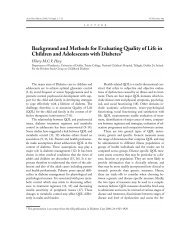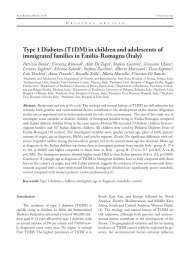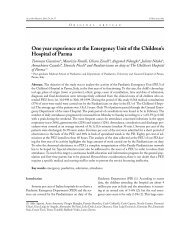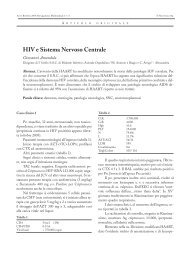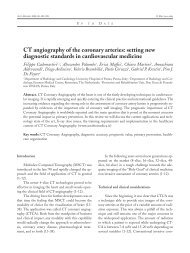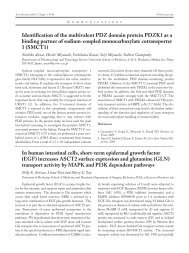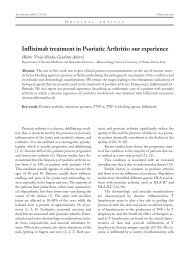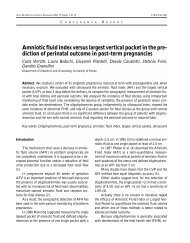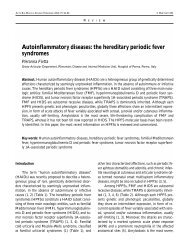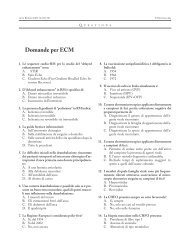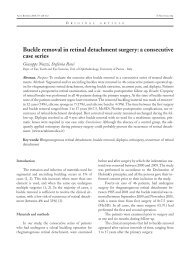Contribution of studies on renal effects of heavy metals and selected ...
Contribution of studies on renal effects of heavy metals and selected ...
Contribution of studies on renal effects of heavy metals and selected ...
You also want an ePaper? Increase the reach of your titles
YUMPU automatically turns print PDFs into web optimized ePapers that Google loves.
Toxic nephropathies from industrial chemicals<br />
61<br />
bismuth may also induce kidney damage. Other potentially<br />
nephrotoxic elements include barium, cobalt,<br />
manganese, nickel, silver, thallium, thorium, tin, <strong>and</strong><br />
vanadium. Nephrotoxic properties <str<strong>on</strong>g>of</str<strong>on</strong>g> such elements<br />
arise mainly from the tubular re-absorpti<strong>on</strong> <str<strong>on</strong>g>of</str<strong>on</strong>g> metalprotein<br />
complexes, which increase the epithelial burden<br />
<str<strong>on</strong>g>of</str<strong>on</strong>g> elements interacting with organic macromolecules,<br />
thus starting a cascade <str<strong>on</strong>g>of</str<strong>on</strong>g> events leading to cell<br />
membrane damage <strong>and</strong> oxidative stress. The selective<br />
vulnerability <str<strong>on</strong>g>of</str<strong>on</strong>g> different nephr<strong>on</strong>ic subunits, though<br />
difficult to assess when the <strong>renal</strong> functi<strong>on</strong>al reserve is<br />
severely impaired, can result in an increased β 2 -microglobulin<br />
excreti<strong>on</strong> following Na 2 CrO 4 administrati<strong>on</strong><br />
<strong>and</strong> chr<strong>on</strong>ic exposure to cadmium, thus revealing<br />
a damage preferentially occurring at the initial segment<br />
<str<strong>on</strong>g>of</str<strong>on</strong>g> proximal c<strong>on</strong>voluted tubule (S1), whereas elements<br />
damaging intermediate <strong>and</strong> distal segments<br />
(S2-S3) include inorganic mercury <strong>and</strong> lead (22).<br />
a) Chromium <strong>and</strong> chromium compounds<br />
Epidemiological investigati<strong>on</strong>s <strong>and</strong> animal <str<strong>on</strong>g>studies</str<strong>on</strong>g><br />
have shown that measuring the urinary excreti<strong>on</strong> <str<strong>on</strong>g>of</str<strong>on</strong>g> low<br />
molecular weight proteins may be useful to m<strong>on</strong>itor <strong>renal</strong><br />
dysfuncti<strong>on</strong> (23). Cross-secti<strong>on</strong>al investigati<strong>on</strong>s<br />
gave evidence <str<strong>on</strong>g>of</str<strong>on</strong>g> mild tubular dysfuncti<strong>on</strong> in chromeplaters<br />
<strong>and</strong> welders occupati<strong>on</strong>ally exposed to watersoluble<br />
chromium(VI) (18). It was clearly established<br />
that chromium(VI) compounds arises from its direct<br />
cytotoxicity towards epithelial tubular cells. Experimental<br />
<str<strong>on</strong>g>studies</str<strong>on</strong>g> have shown an epithelial impairment<br />
leading to a progressive dose-dependent tubular epithelial<br />
necrosis <str<strong>on</strong>g>of</str<strong>on</strong>g> this nephr<strong>on</strong>ic subunit (23). Franchini<br />
<strong>and</strong> Mutti (24) assessed dose-effect/resp<strong>on</strong>se relati<strong>on</strong>ships<br />
between the urinary excreti<strong>on</strong> <str<strong>on</strong>g>of</str<strong>on</strong>g> chromium <strong>and</strong><br />
that <str<strong>on</strong>g>of</str<strong>on</strong>g> retinol-binding protein or the <strong>renal</strong> antigen BB-<br />
50. Most <str<strong>on</strong>g>of</str<strong>on</strong>g> the abnormal values were observed in subjects<br />
with urinary excreti<strong>on</strong> <str<strong>on</strong>g>of</str<strong>on</strong>g> chromium greater than<br />
15 µg/g creatinine; however, above this threshold the<br />
degree <str<strong>on</strong>g>of</str<strong>on</strong>g> tubular impairment was not related to urinary<br />
excreti<strong>on</strong> <str<strong>on</strong>g>of</str<strong>on</strong>g> chromium. It was c<strong>on</strong>cluded that the tubular<br />
damage following chromium exposure is presumably<br />
transient <strong>and</strong> mostly due to acute exposure (24).<br />
b) Mercury <strong>and</strong> mercury compounds<br />
The toxicity <str<strong>on</strong>g>of</str<strong>on</strong>g> mercury depends <strong>on</strong> both its<br />
chemical form <strong>and</strong> the route <str<strong>on</strong>g>of</str<strong>on</strong>g> absorpti<strong>on</strong>. In rats, relatively<br />
high doses <str<strong>on</strong>g>of</str<strong>on</strong>g> HgCl 2 (>10 mg/kg b.w. s.c.) induce<br />
severe haemodynamic changes <strong>and</strong> backleak,<br />
which c<strong>on</strong>tributes to the reducti<strong>on</strong> in creatinine clearance<br />
induced by outer cortical ischemia with relevant<br />
impairment <str<strong>on</strong>g>of</str<strong>on</strong>g> glomerular functi<strong>on</strong>, whereas n<strong>on</strong> critical<br />
doses (0.6-1.8 mg/kg s.c.) can determine dramatic<br />
increases in RBP excreti<strong>on</strong>, reabsorbed mainly at<br />
distal level <str<strong>on</strong>g>of</str<strong>on</strong>g> proximal tubule, as well as a slight increase<br />
in albumin excreti<strong>on</strong> (microalbuminuria) (22).<br />
Such microalbuminuria found in animal models using<br />
subcritical doses represents a biomarker <str<strong>on</strong>g>of</str<strong>on</strong>g> tubular impairment<br />
<str<strong>on</strong>g>of</str<strong>on</strong>g> reabsorpti<strong>on</strong> <str<strong>on</strong>g>of</str<strong>on</strong>g> filtered plasmaproteins,<br />
since the complete integrity <str<strong>on</strong>g>of</str<strong>on</strong>g> the whole tubular segment<br />
is required to efficiently perform this physiological<br />
functi<strong>on</strong> (22).<br />
Occupati<strong>on</strong>al exposure to elemental mercury for a<br />
decade with urinary c<strong>on</strong>centrati<strong>on</strong>s exceeding 50 µg/dl<br />
is associated with increased human intestinal alkaline<br />
phosphatase (HIAP) excreti<strong>on</strong> but little increase in<br />
urinary tissue n<strong>on</strong>-specific alkaline phosphatase NAG,<br />
RBP. β 2 -microglobulin, or microalbuminuria (25, 26).<br />
More recently, in subjects occupati<strong>on</strong>ally exposed to<br />
lower Hg c<strong>on</strong>centrati<strong>on</strong>s, leading to Hg-U levels between<br />
2.3 to 35.0 µg/g creatinine, no significant prevalence<br />
<str<strong>on</strong>g>of</str<strong>on</strong>g> abnormal values for the above biomarkers have<br />
been observed (27).<br />
Sporadic case reports <str<strong>on</strong>g>of</str<strong>on</strong>g> nephrotic syndrome following<br />
exposure to elemental or organic mercury have<br />
appeared since the middle <str<strong>on</strong>g>of</str<strong>on</strong>g> the past century but, in<br />
occupati<strong>on</strong>al setting, the causal relati<strong>on</strong>ship <str<strong>on</strong>g>of</str<strong>on</strong>g> mercury<br />
exposure to proteinuria <strong>and</strong> the nephrotic syndrome<br />
has been less compelling, because the dose-resp<strong>on</strong>se<br />
is unpredictable <strong>and</strong> the etiology <str<strong>on</strong>g>of</str<strong>on</strong>g> nephrotic<br />
syndrome unrelated to mercury is rarely known. Observati<strong>on</strong>s<br />
in rats may provide a framework for underst<strong>and</strong>ing<br />
mercury-induced glomerular disease in humans.<br />
Multiple subcutaneous injecti<strong>on</strong>s <str<strong>on</strong>g>of</str<strong>on</strong>g> HgCl 2 in<br />
rats, in doses too small to produce acute tubular necrosis,<br />
induced membranous nephropathy, a <strong>renal</strong> disease<br />
characterized by glomerular depositi<strong>on</strong> <str<strong>on</strong>g>of</str<strong>on</strong>g> immune<br />
complexes <strong>and</strong> <strong>heavy</strong> proteinuria (28). The resp<strong>on</strong>se to<br />
mercury in the rat is under genetic c<strong>on</strong>trol <strong>and</strong> dosedependent<br />
(29, 30). As little as 0.005 mg/100 g b.w.<br />
elicit immunologically mediated glomerular disease in<br />
<strong>selected</strong> strains. Metallic mercury vapor (1 mg/m 3 ) is<br />
as effective as HgCl 2 for inducing autoimmune disease



